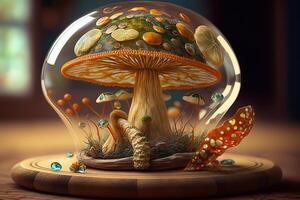Cannabis, CBD, Magic Mushrooms, Psilocybin
Whole Mushroom vs. Isolated Psilocybin: Which Delivers True Potency?
Psychedelic research and mental health discourse are increasingly drawn to a nuanced debate: Is the whole mushroom or isolated psilocybin the truly potent, therapeutic option? The answer, as emerging science and experience suggest, is more complex than simply measuring milligrams of an active compound.
The Chemistry: More Than Just Psilocybin
Psilocybin mushrooms are renowned for their content of psilocybin—a prodrug that the body converts into psilocin, responsible for psychedelic effects. But these mushrooms are chemically diverse. Besides psilocybin and psilocin, whole mushrooms may also contain:
- Baeocystin and norbaeocystin: Minor analogues with similar (but milder) psychoactive effects.
- Aeruginascin, tryptophan, serotonin, and phenylethylamine: These compounds may influence the psychedelic or therapeutic experience, contributing to what some call an entourage effect—the hypothesis that a plant or fungus’s full spectrum of compounds works synergistically to enhance therapeutic outcomes.
In contrast, isolated psilocybin is usually pharmacologically pure. It eliminates the variables of other compounds, providing a known dose with predictably consistent effects. For clinical research, this purity provides rigour and safety, but may miss out on potential synergies present in the whole mushroom experience.
The Potency Question: What Does Science Show?
Potency can be understood as both the strength of effect per dose and quality of outcome.
Whole Mushroom
- Variability: The psilocybin (and total psychoactive) content in whole mushrooms varies dramatically by species, strain, growing conditions, and preparation. For example, the psilocybin content can range from as low as 0.03% to as high as 2.5% of dried weight in different species and even within the same strain.
- User Reports and Subjective Potency: Many experienced users and some early scientific interviews note that whole mushrooms feel “more alive and vibrant,” with a gentler onset and comedown compared to purely synthetic psilocybin.
- Entourage Effect Evidence: In recent preclinical studies, mushroom extract demonstrated superior or equal effectiveness in reducing OCD-like symptoms in mice at lower doses than synthetic psilocybin, suggesting possible amplification from minor compounds. Mushroom extracts also showed a more enduring effect on neuroplasticity markers in the brain, suggesting their impact may outlast that of synthetic psilocybin alone.
Isolated Psilocybin
- Consistency and Control: Isolated psilocybin offers precision in dosing, essential for clinical trials and standardized therapy. Every dose contains precisely measured psilocybin, avoiding the unpredictability of whole mushroom potency.
- Pharmacological Effects: At equivalent doses, isolated psilocybin reliably produces the hallmark psychedelic effects—visual distortions, emotional shifts, mystical experiences, and alterations in perception.
- Therapeutic Application: Isolated psilocybin is currently the predominant form in clinical settings, as its known purity minimizes variable risk factors and aligns with medical regulations.
Beyond Numbers: Is One Truly Superior?
Although isolated psilocybin is attractive for research and medical use, whole mushrooms may deliver benefits beyond just the main active ingredient.
Potential Advantages of Whole Mushroom:
- Synergy: Multiple compounds may enhance psilocybin’s effects, either physiologically or subjectively. The unique blend of chemicals might modulate potency, reduce anxiety, or impart a smoother experience, similar to the “entourage effect” well established in cannabis research.
- Distinct Experience: Many users report that natural mushrooms can feel deeper, more holistic, or even “sacred,” as opposed to what’s described as the “dummied-down” experience of pure psilocybin.
- Therapeutic Potential: Early animal studies indicate that whole mushroom or extract can outperform isolated psilocybin in neuroplasticity and behavioral outcomes, hinting at novel mechanisms at play.
Challenges with Whole Mushroom:
- Variation in Strength: Natural mushroom compounds are susceptible to environmental and genetic variability, making exact dosing difficult and potentially risky in clinical practice.
- Safety and Consistency: For critically ill or sensitive populations, the unpredictability of whole mushrooms remains a significant concern.
Table: Key Differences at a Glance
| Feature | Whole Mushroom | Isolated Psilocybin |
|---|---|---|
| Chemical Makeup | Mix of psilocybin, psilocin, other alkaloids | Pure psilocybin |
| Dosing Consistency | Variable by strain/grow/part | Highly consistent |
| User-Reported Experience | “Vibrant,” “alive,” complex | Predictable, standardized |
| Evidence for Entourage Effect | Preclinical and anecdotal support | No entourage, single-molecule focus |
| Clinical Suitability | Increasing but challenging | Medical gold standard |
The Verdict: Which Is Truly Potent?
True potency isn’t just about chemical strength, but about the quality and depth of the experience and its therapeutic effects.
- Whole mushrooms likely offer a broader and possibly richer psychedelic experience, enhanced by the interaction of multiple natural compounds—delivering true potency for those seeking depth, psycho-spiritual connection, and complex therapeutic outcomes.
- Isolated psilocybin remains the gold standard for consistent and safe medical administration, providing reliably potent effects for clinical and research use.
Emerging research now suggests that the unique profile of whole mushrooms—or even full-spectrum extracts—may exhibit therapeutic advantages over the single-molecule approach. The future may see a synthesis of both strategies, harnessing the wisdom of nature alongside the rigor of modern science

